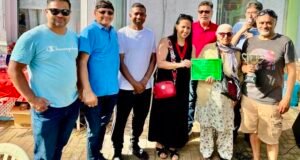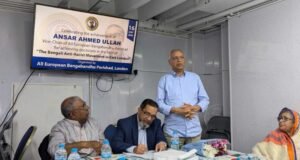
Ansar Ahmed Ullah:
A photography exhibition has opened at Four Corners, Roman Road, Bethnal Green this month, chronicling the lives of Robin Hood Gardens in Poplar, East London, residents in the estate’s last years before demolition.
An iconic ‘Streets in the Sky’ housing scheme, Robin Hood Gardens had been celebrated as a masterpiece of modernism and reviled as a ‘concrete monstrosity’. Yet in such accounts residents’ own voices were rarely heard. Against these representations and the social-cleansing agenda that they served, Kois Miah’s photographs chronicle the lives, emotions, and routines that animate this extraordinary council estate.
In Kois Miah’s’ tender images, Brutalism is a living architecture. His portraits show not melancholia for an outmoded social experiment, as council estates are too often portrayed, but a vibrant community cut short by the destruction of regeneration.

Motiur Rahman, a resident for 23 years, remembers the estate, ‘We always talked about the walkways being like Bangladesh. People did unbelievable things on them, like riding bikes – I don’t mean one bike but four bikes going past each other. They played Carrom Board – it was so wide. In Eid, the doors would be open in every house and you would have all these people, swathes of people going up and down the corridors in their glitzy outfits, going to people’s houses, eating samosas. It gave you the opportunity to live an outdoor life.’
The building acclaimed as a significant example of Brutalist social housing, Robin Hood Gardens was designed by British architects Alison and Peter Smithson and completed in 1972. Located in Poplar, East London, the estate is characterised by its broad concrete walkways: ‘streets in the sky’ designed to lift the homes up into the open air and to foster a sense of community.
Less than 50 years later the estate is undergoing demolition, despite a long-running campaign to save it, supported by architects including Zaha Hadid, Toyo Ito,Richard Rogers and Robert Venturi.

Moyna Miah and his grandchildren.
Photographer Kois Miah and sociologist Nick Thoburn commented, “Too often today council estates are stigmatised or described, with regret or melancholy, as belonging to the past. Such accounts are helping to justify the demolition and rebuild of scores of estates across London, in what amounts to a massive land grab by property developers and speculative investors. On the contrary, we hope that visitors will find in this exhibition images that stand against those negative accounts. These photographs celebrate a vibrant London community and the lived experience of experimental social architecture, cut short by the destruction of regeneration. We chose to exhibit at Four Corners because of its longstanding commitment to promote community-wide participation and its location in east London amidst numerous council estates, whose residents we’re inviting to visit and take part in the exhibition events.”
The exhibition is part of a research collaboration with Nick Thoburn, sociologist at the University of Manchester, Aklima Begum & Runa Khalique whose interviews with residents and writing about the estate accompany the portraits by Kois Miah.
The exhibition is accompanied by a lively events programme of talks on Brutalism, Robin Hood Gardens, and Council Housing ‘As Found’ on 1 June examining current debates around Brutalist architecture and the role that art can play in Britain’s social housing crisis and Social Housing Not Social Cleansing! On 8 June talks by campaigners against the demolition and regeneration of London council estates.
The entrance to the exhibition is free, Tuesday to Saturday 11am-6pm and runs till 8 June at Four Corners, Roman Road, Bethnal Green E2 0QN.
 Weekly Bangla Mirror | Bangla Mirror, Bangladeshi news in UK, bangla mirror news
Weekly Bangla Mirror | Bangla Mirror, Bangladeshi news in UK, bangla mirror news






